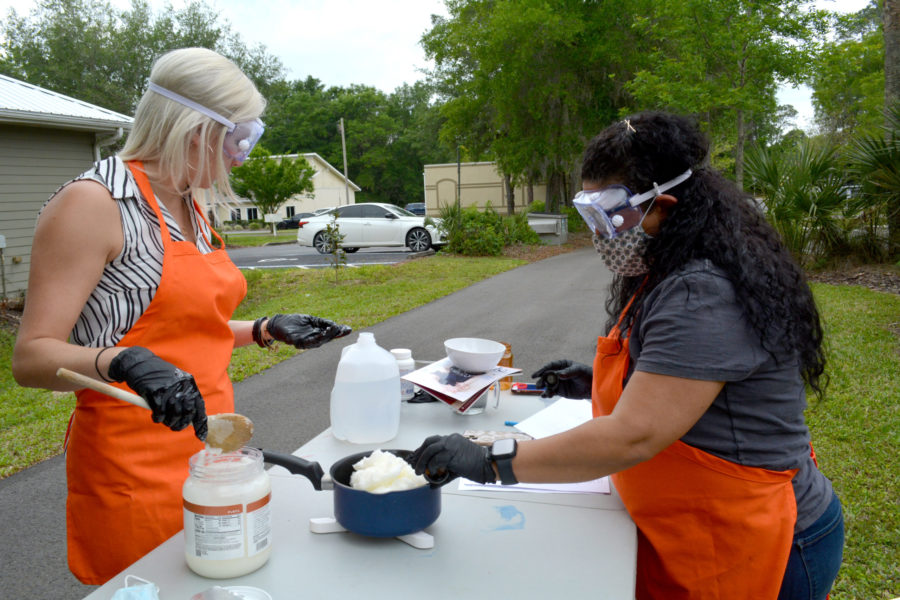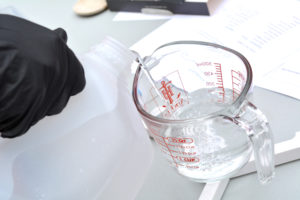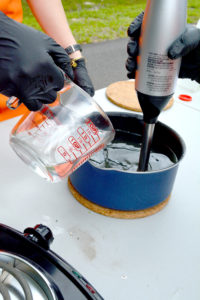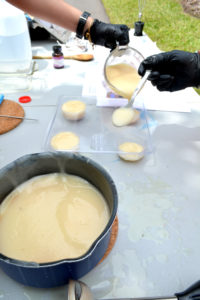We were inspired by our story about soap in this issue so we tried to make our own. We decided to make soap using the cold-pressed process. We will be honest, this was not a simple undertaking.
For our recipe, we found the simplest one we could find on the web. There are 1,001, so we suggest if you are going to try, that you pick the one that works well for you and has the ingredients that you will enjoy using. For our cold-pressed recipe, we used coconut oil, lye, distilled water and essential oils. We wanted it to be as simple as possible.
Once we had our recipe, we had to hunt down 100% lye in town. After scouring the shelves of a few stores, we did find some at our local Ace Hardware store. Tip, it is behind the counter, so don’t waste time going up and down the aisles like I did. Just ask! The rest of the ingredients and materials were found at Publix, Walmart and our kitchen.
Once we had everything together, we set up our soap making station outside. NOTE: Lye is extremely dangerous and caustic. We used extreme safety measures during the process: we wore goggles and gloves for protection plus worked outside for proper ventilation. We took no chances, and frankly, we even second guessed ourselves as to what we were doing.
In a nutshell: We did make a few errors and we were very nervous about working with the lye after reading all the warning labels. We found It was very helpful to do it in a team, as one person read directions, one person stirred and measured. By the end, we were very proud to say that we made SOAP! Would we do it again? I think so!
OVERALL: 3.5 STARS
FIND A RECIPE ONLINE OR TRY OURS!
What you will need:
• Gloves
• Goggles
• Large measuring cup
• Meat thermometer
• Wooden Spoon
• Large pot
• Hand blender
• Kitchen scale
• Mason jar
• Parchment paper
• Mold for soap (loaf pan works fine)
• 3/4 cup distilled water • 4 oz Lye flakes
• 33 oz Coconut oil
• 1oz bottle vanilla essential oil
Directions:
1. Zero out your kitchen scale and measure the distilled water in the large measuring cup.
2. Zero out the kitchen scale again and measure the lye in a mason jar.
3. SLOWLY pour the lye into the water without spilling or splashing while simultaneously stirring with the wooden spoon. It is important not to do this step the other way around.
4. Place a covering of some sort (we used a magazine) over the top of the lye water as it heats up and immediately rinse the spoon used for stirring.
5. Measure out oil in a large pot and place on a burner on medium heat. Wait until oil is at about 100˚F.
6. Take off of the burner and slowly pour the lye water into the oil. At the same time, use the hand blender on the low setting to blend the mixture in short bursts until it becomes thick and cloudy. NOTE: Make sure blender is deep enough in the mixture to prevent slashing.
7. Add fragrance or essential oils to the mixture and blend, then place in mold. Let sit for 24 hours or up to four weeks to completely cure.
8. Keep gloves on while you clean up any remaining residue and thoroughly wash any supplies used in the process.
This recipe is an adaptation of another soap recipe. For a more detailed explanation of the soap making process, visit thesprucecrafts.com.
RELATED ARTICLES
Eye Twitches: When is it Serious?
We Tried It! Plant-Based Burgers
You Don’t Need to Live with Knee Pain




